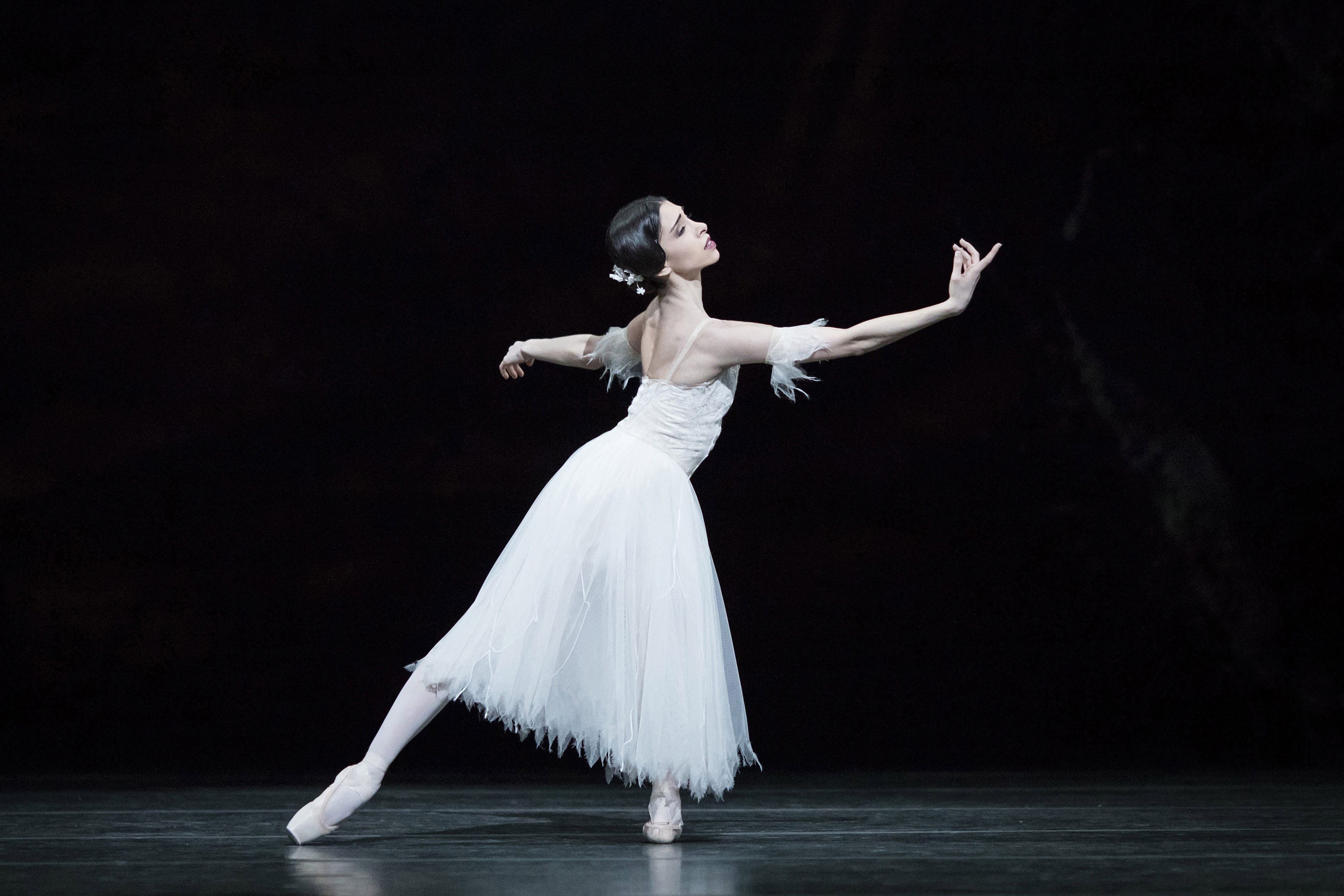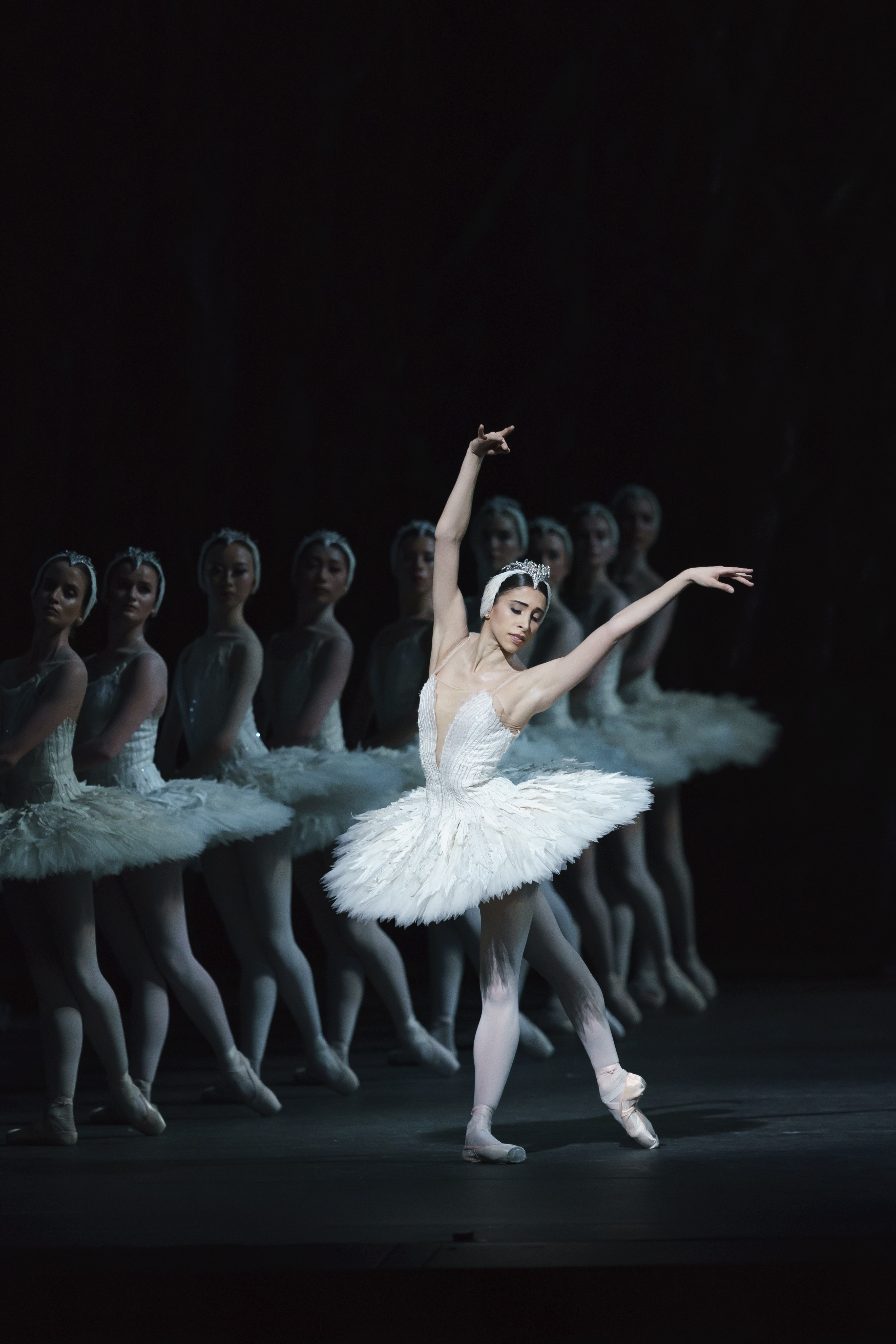

Yasmine Naghdi, a Principal Dancer for the Royal Ballet, was glorious this season as Juliet in choreographer Kenneth MacMillan’s interpretation of Shakespeare’s Romeo and Juliet. The dance critic in the British Theatre Guide wrote, “Naghdi is gorgeous and faultless in whatever she does, and here she acts and dances Juliet to nuanced perfection.”
This week she opens in Giselle, dancing the title role in the iconic staging of the work by choreographer Peter Wright.
This week on November 10th she opens in Giselle, dancing the title role in the iconic staging of the work by choreographer Peter Wright. She will dance the role again on November 20th and appear in the Royal Ballet’s streaming of the ballet on December 3rd. “Giselle is one of those ballets we are forever striving to get right,” she tells me when I meet her backstage at the Royal Opera House after a day of rehearsals and classes. “It’s full-bodied. You have completely contrasting acts. In Act One, you are a human being and your are portraying a rather naive and provincial and weak character. A young girl, but very different than the role of Juliet. She is one who is wanting to trust and wanting to be loved and has a profound love of dance. So to portray that character and to get her right, she needs Albrecht. He’s a stranger essentially but she falls for him. She wants to trust him but is hesitant but then gives herself over to him. Then it leads her discovering that he’s actually engaged to a princess. That completely breaks her heart and she is someone who has the disposition of having a weak heart anyway. In our version, she dies of stabbing herself. She then appears in Act Two as a spirit. So there you have the contrast between human being and spirit. You have to make yourself feel otherworldly – like smoke lasting in the air – or your movements have to be very held and drawn out. There is a lot of jumping in both acts. A lot of jumping. So there is a lot of lower leg work that has to go into the preparation. But I find as it is a romantic ballet, it has a certain style. We are dancing this romantic ballet that was first done many years ago in 1841, so it still needs that style to come through. It is again just one of those ballets you are just striving to get right. There is that pinnacle moment of the mad scene that features in Act One and that’s where you can play with it a bit and change it up. You can put your own flavor to that. But will one ever get it right? Yet that is the beauty of art: it’s subjective. You might think this dancer did it so well and that one didn’t , and vice versa. It is a challenging ballet. It is technically challenging but it is the emotion you bring across to the audience that is the biggest challenge.”
The other challenging roles for which Naghdi is known in the company where she has spent her entire career so far include, among others, Odette/Odile (Swan Lake), Aurora (The Sleeping Beauty), Gamzatti (La Bayadère), Kitri (Don Quixote), Tatiana (Onegin), Swanilda (Coppelia), Sugar Plum Fairy (The Nutcracker).
Here are some of the other questions I asked the ballerina as we continued our conversation that day backstage at the Royal Opera House.
I watched a few live streaming performances that the Royal Ballet performed in the empty Royal Opera House during the pandemic. But there is nothing like performing for a house filled with balletomanes. How did the pandemic and the lockdown affect you as a dancer?
We’ve all grown in the pandemic. We’ve all become different people. I have a lot of personal growth during the time of the pandemic. In a good way, I’d say. I have had a lot of positive growth and I am approaching things in a more positive way.
I am always looking to reinvent myself as an artist – and as a person, I’d say. But I find that the pandemic gave me time to take a step back and reflect on the things I was maybe making a big deal out of that I didn’t need to make a big deal out of. I’m a very worrisome person. I would always over analyze. I worried a lot about everything. I would worry about worrying. So I took the pandemic to take a step back to realize what’s important and what’s not important to worry about anymore – such as things that are not in my control which is often a lot in the ballet world.
It seems so far I seem to be handling things a little better. I’m trusting myself more – and that is a really hard thing for a dancer to do because we are so hypercritical. It’s always, this isn’t good and that isn’t good and I slipped in that bit of the performance and holding on to that. When we were doing those performances of the triple bills we streamed during the pandemic time, if there were a little thing that would go wrong I would completely beat myself up about it. And get really upset. If the show went well, I’d be okay fantastic I’m moving on. I stopped and thought that is really a twisted way of looking at your work – to focus on the bad all the time. That comes from a perfectionist trait. But I’m trying to kind of turn it around. If something bad happens, it’s a moment in time. Don’t focus on that.
I think it is in the dancer’s nature [because of always having another pair of eyes on us] to wish for positive feedback, to get that tap on the shoulder that we are doing the right thing. We want to know that. But as one grows older you have to try and find that for yourself. That’s what I’m trying to do. To get my own appreciation and to give myself a tap on the shoulder.
That said, the ballet world is particular and the fans can be, well, fanatical – especially when we go to Japan. It’s on a whole other level. When we come out of the stage door there are barriers to keep the people away. It’s humbling that they appreciate the work that we put in. It’s a beautiful part of the job. I like meeting people after performances and hearing how I’ve maybe moved them. There was one particular moment that stands out for me. There was a woman who was suffering from a lot of back pain. I met her after a performance and she was crying. I gave her a hug – this was pre-COVID. She told me she wanted to thank me because I had made her forget her pain. “You gave me three hours in which I was not in pain,” she told me.

Dancers are not just artists but also athletes. Your art is embedded in your body and thus it is art performed by young people. The stage is filled with the young – even the Principal Dancer ranks. You are young in a demanding and competitive world – much like professional sports – when you don’t know yourself yet. Plus, you’re always being choreographed which is basically being told what to do. So is one’s maturity stunted in such a world or is one preternaturally mature for existing – even surviving – in it?
It’s a very interesting thing to look at because I got my first really big opportunity young to do the role of Juliet in Romeo and Juliet when I was still a soloist. I was around 22. I feel like dancing that as a soloist and stepping into a Principal Dancer position was the perfect thing because of the role. She is so young herself and you have that natural effervescence. That natural youth and excitement. I think it worked really, really well for the role of Juliet. Each time I revisit it years later, I try to go back to the feelings I had when I first did it. So I think there is a beauty in youth and in seeing a young dancer onstage often unaffected with nerves. Usually you’re less nervous when you’re younger. You’re really trying to prove yourself so you’ve got that drive. And I think the change as one gets older is that the nerves start setting in because you think you have your position to uphold. You’ve got more experience and with more experience you become more critical of yourself. It’s an interesting circle, I’d say. It’s a pressure.
The image I like to use is of a horse with its blinders on. I’d say to myself, just have these blinders on and focus on yourself. Don’t get distracted by all “the noise” around you. Easier said than done. Like Baryshnikov said, “You’re only in competition with yourself.”
So what is your background, Yasmine?
I was born in London and grew up in West London around Kensington. I went to school at Hill House International. It’s a school that has very funny uniforms. You see these kids walking around Sloane Square wearing these knickerbockers that are a bronzy color and jumpers that are bright yellow. They’ve still got them. They haven’t updated the costumes. Costumes? Uniforms.
Naghdi is a Persian last name. My dad is Persian. He’s not Muslim. He’s Zoroastrian. My mother is Belgian. I’m mixed heritage. My name is not typically British. It’s funny though. I never paid much attention to being different [in the ballet world]. And I suppose I was. I think now we’ve really got that conversation going. But I really never paid much attention to being different. Now I’m quite proud of it, I’d say.
I have a bit of Georgian heritage as well. On my father’s side they were all sort of high up generals in the army in Iran. Tehran, the capital. But they weren’t religious. This was during the Shah. When the revolution happened they left Iran and he has not gone back. I have an uncle who still lives in Iran but the rest of my dad’s family lives in Geneva, Switzerland. I spent my half-terms, my Easters, my summers either going to Geneva speaking French with that side of the family or going to Belgian and speaking Flemish with my mum’s side of the family.
Let’s keep the conversation going about family. You recently got engaged. Before you were engaged to your husband-to-be, you were not only engaged with your work, but in some deeper way to it. It was the relationship in your life. It was, well, your partner. You were partnering with ballet itself. Now another partner has, I presume, taken precedence. How has your engagement to be married changed your relationship to ballet?
Hmmm. This is a nice thing to talk about. I would say, I feel really complete in my personal life. I feel I found my soulmate. And we’ve made a step in a really lovely direction. I’d say it gives me perspective. At the end of the day no matter what’s happened onstage good or bad, I’ve got my person there I can come home to and everything is all right. I think there is beauty in that kind of security. And it’s nice to plan for the future as well.
He’s not a dancer. He’s in finance. And being in the ballet world is an all-encompassing journey. I think I’ve kept myself mentally healthy by having a life outside of ballet. I like taking holiday. I like taking time out. I like switching off. Because by doing that, I recharge my batteries to come back and love it again. I think it’s a very personal thing. Some people think they have to stay in it the whole time. I know back in the Balanchine days you were married to ballet. It was ballet or nothing. Back in MacMillan’s time, too, you hear of stories of ballerinas giving up having a child because ballet was number one for them. I think it is wonderful that it is a much more open world now and accepting of life outside of dance.
I’m definitely a planner [regarding children] but, of course, I have to have an open mind because life sometimes throws some curveballs at you. One must be prepared for anything really. So having a life outside of dance helps. I’d like to think when that time comes, I’d hang up my ballet shoes – just not for a long time when it happens. I’d like to think I will approach that in a really wholesome way. I presume that having a child makes you grow as a person. You change. You’re not the same person you were the year before. But I think you can bring even more weight to your work. And I’ve heard that often dancers come back better than they were before they had a child.
I’m not worried about the gain of weight with a pregnancy. I’ve been very blessed with a body that can take the strains of dance. I’ve never had to watch my weight. I’ve been very lucky having an awesome metabolism and having a really healthy relationship with food. I love food. My fiancé is Italian. Pasta is my number one priority. My husband and I love cooking together. Usually one person likes to be alone cooking in the kitchen. But we love cooking together. I’d say the favorite meal we love to cook together is Pasta con le Vongole* which is a classic Italian dish. We change up who is the sous chef. Sometimes he’s in charge. Sometime I’m in charge. La dolce vita really features in my life. I love food. I love cooking. I love going to restaurants and all that comes with that. So I’m not afraid of gaining weight when I know that time will come because I know that my body needs to do what it needs to do.
When you do have children, your daughter or your son might want to go into the ballet. What advice would you give them as a prima ballerina and what advice would you give the as a mother?
I discuss this in my mother’s book. It’s titled Tears of a Ballet Mum by Sabine Naghdi. It’s coming out the end of November. So stay tuned for that. It is about tears of joy and tears of sadness. All kinds of tears. We have a conversation at the end of the book and she asks me the same question.
I know what it takes and I know it’s a hard journey. So I would obviously be wary and kind of make them aware of how hard it is. But or course if either my son or my daughter would want to pursue it and feels very strongly about it, I would support it in any way that I can. I would offer advice and offer my experience and hope that they would take on that advice. But ultimately if a child comes to you and tells you they dream of doing something, who am I to tell them otherwise. I’d like to think I would support them no matter what they would want to do.
I am the first artistic person to emerge from my family, hands-down. I’m a one-off. But I was completely encouraged and I would not be where I am without the support of my parents. When the question came of do we let Yasmine pursue this and who knows what will happen and is she following the right path and is her mind going to be okay, my mum was reading the Gelsey Kirkland autobiography which is a bit scary. My dad was very much, no, she’s good at this and she’s good at that and she needs to go to university and she needs to pursue another course. And my mum was a little bit more let’s see and if she doesn’t like it she can always do something else. But they ended up supporting me every step of the way. I’ve never had a regret that I chose this path.
- 320-400 g linguine (11-14oz) or spaghetti
- 800 g fresh clams (1.8lbs) about 200g/7oz per person
- 3-4garlic cloves peeled and finely chopped
- 1 peperoncino (red chili pepper) or dried chili flakes (amount depends on your preference)
- Generous amount of olive oil/extra virgin olive oil.
- 1-2 handfuls fresh parsley, finely chopped.
- salt – to add after cooking the clams (the clams naturally add salt to the dish!)
- 1/2 glass dry white wine







